There’s no such thing as bad weather, just soft people.
– Bill Bowerman, Nike co-founder and Pacific Northwest icon
January. The word sounds cold, evoking as it does images of textureless gray skies, barren snowy landscapes and people dressed like South Park characters. Although I largely escape winter by living on the Pacific margin of the U.S., here in the East Bay temperatures still dip into the suboptimal 30s this time of year. And with few exceptions, January signals the nadir of the racing season.
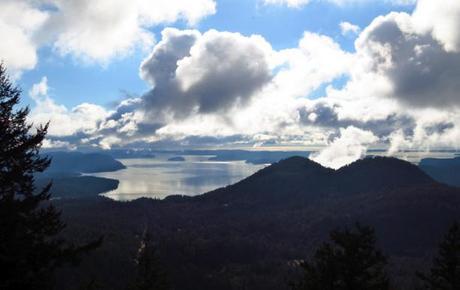
Friday’s view from Orcas Island, with blue sky and gray clouds battling for dominance
So for my first January race ever, you might think I’d choose a warm-weather outing in one of the more cold-resistant pockets of the country. Maybe, say, the Disney World Marathon in balmy Florida. Or the Rock ‘n’ Roll Half in hot ‘n’ dry Arizona. Or maybe even stuff my swimsuit, running shoes and Garmin into a small duffel and head out across the ocean for the tropical Maui Oceanfront Marathon. All logical, common sense choices.
Unfortunately, common sense didn’t cast the deciding vote this time… Julie did.
We’re told to keep our friends close and our enemies closer. To that sound advice I’d add one more inner circle for people like Julie. She’s been one of my closest friends since we met in graduate school. She knew me back when my diet favored the “carbonated” and “partially hydrogenated” food groups. We attended each other’s weddings, and she even picked me up from the airport one New Year’s Eve (!) when I could barely stay upright with the flu. The world would be a shinier, happier place if everyone had a Julie in their lives. And I’m not just saying that because she might stumble on this post one day while Googling herself.
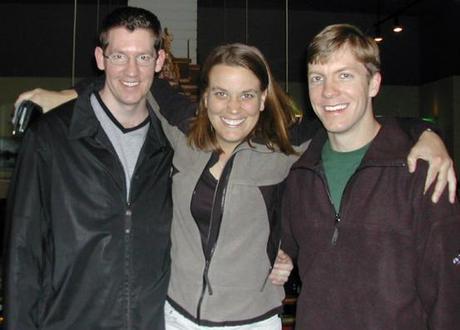
“A long time ago, we used to be friends…”
Julie now lives with her husband David and two children in Redmond WA, best known to the rest of the world as the home of Microsoft. Surprisingly, we’d never run a race together, though not for lack of trying on her part:
- She threatened to bully me into running the Eugene Marathon with her in May 2010. She didn’t, so I didn’t.
- She floated the idea of organizing a team for the Ragnar Relay Northwest Passage, an idea I supported but which due to miscommunication died a quiet, neglected death.
- She invited me to run the Victoria Marathon last year… on the same day I’d be running Chicago.
- I suggested the Seattle Rock ‘n’ Roll Marathon in June, but was told “The Seattle Marathon isn’t all that interesting.”
- At one point she even offered, “I’m sure I can organize a small race in the middle of nowhere for a cause no one will want to support.” That may have been her most enticing offer yet.
Finally, this past August she appealed to my trail-running sensibilities and sold me on the Orcas Island 25K, a mid-winter event staged by the folks at Rainshadow Running, a Pacific Northwest-based trail racing outfit. Several members of her local running contingent would also be running Orcas Island, and when I sent her my registration confirmation she was pumped. Psyched. Excited. Like a mosquito in a nudist colony.
And so it was that Saturday found me within snuggling distance of the Canadian border. Roughly 30 miles northeast of Victoria, British Columbia and 40 miles south of Vancouver as the crow flies, Orcas Island is the largest of the San Juan Islands located in the northwestern corner of Washington state. The race itself would begin and end at Camp Moran in Moran State Park and feature a climb to the summit of Mount Constitution, the highest point on the island at 2,409ft.
Katie and I flew to dreary-but-dry Seattle on THURSDAY, where after landing I kept a tight grip on my MacBook just in case the airport security/Microsoft gestapo got any ideas.
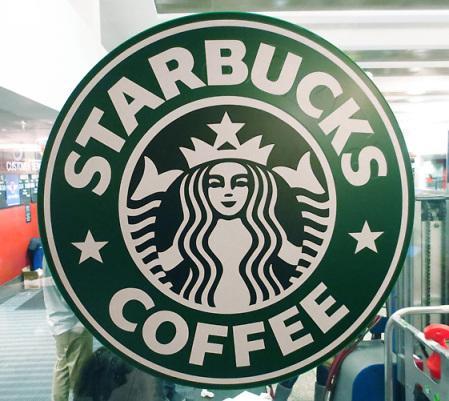
Clearly we’d landed in Seattle… where else do you see one of these?
FRIDAY morning we packed our gear into Julie’s SUV and, joined by her running buddies Charlotte and Kathie, drove the 80 miles to Anacortes before hopping a ferry to Orcas Island. En route we saw seals, great blue heron, and plenty of seagulls. We saw no orcas. I was ready to sue someone for false advertising.
Four hours after leaving Redmond we docked at sunny Orcas Island, where the mercurial winter sky dangled the possibility of dry race conditions. We’d seen the forecast and knew better. After a brief reconnaissance drive up Mount Constitution, we checked in at the Doe Bay Resort on the eastern edge of the island. Doe Bay is located within 6 miles of the race start and offers simple, no-frills cabin lodging that I’d recommend to anyone visiting the island. Though somehow the five of us couldn’t find time for the clothing-optional soaking tubs at the resort. Maybe next time…
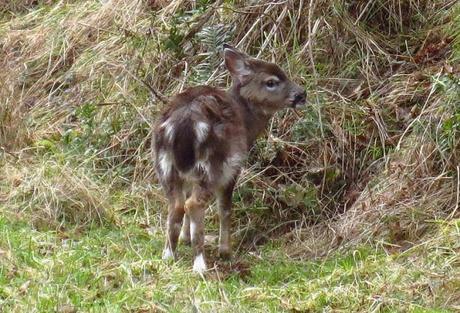
That’s no killer whale! Oh, wait, we must be in Doe Bay
After killing two hours in the sleepy bayside town of Eastsound, we made our way to Camp Moran for the optional check-in and bib pickup. Here we also experienced Rainshadow Running’s clever, quirky alternative to the traditional race t-shirt: in the interest of conserving and reusing resources, the RR crew scour thrift stores for diverse articles of clothing, onto which they have printed the Orcas Island race logo. Fortunately runners were also given the option to save $15 by declining a race “t-shirt” during online registration, an option I enthusiastically endorsed.
Scanning the assembled crowd of jovial runners in their fleece hoodies, puffy down jackets and wool beanie caps, the scene to my mind embodied the Pacific Northwest… if someone had cranked up “Smells Like Teen Spirit” I would’ve guessed Nirvana concert, circa 1992. The low body mass index of the room added to the peculiar irony of this race’s former name, the “Orcas Island Fat Ass 25K.” And speaking of low BMI… I had the opportunity during bib pickup to meet elite trail runner Candice Burt, whom I recognized from a recent Trail Runner email as having set the women’s fastest known time (FKT) during an unsupported run on the 93-mile Wonderland trail around Mount Rainier. She was incredibly gracious and seemed happy to talk to anyone and everyone who approached her.
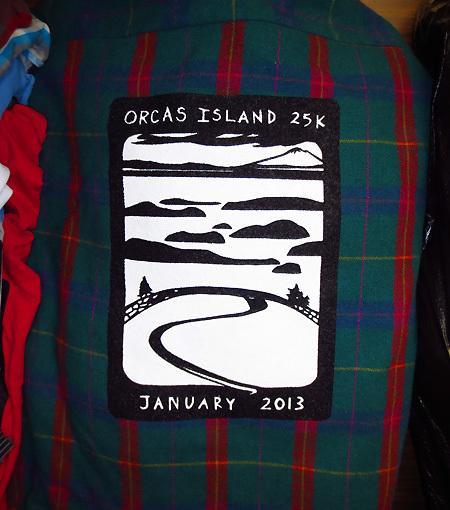
Nothing says “Pacific Northwest runner” like plaid flannel race swag
That evening, while carbo-loading in our Doe Bay cabin, our group voiced two main concerns about the day ahead:
1) The course. The previous week, race director James had inexplicably re-routed the already challenging course to add another 1,000ft of elevation gain, bringing the total elevation gain/loss to 4,450ft. Kathie had been the first to notice James’ announcement posted on the race website: “It seems like every year I’m making some kind of change to the race course… This year’s route is totally different than any of the previous 25k courses and is HARDER THAN EVER!” Julie, Charlotte and Kathie expressed unease over this arbitrary change; I chose to drown my apprehension in a third plate of spaghetti.
2) The weather. Two days before the race, the forecast called for rain at lower elevations, with temperatures ranging from 38-45°F and winds at 11-13 mph; and for snowfall at higher elevations (above 2,000ft), with temps in the mid-30s, winds around 11 mph and new snow accumulation of 1-2 inches. This would be the second time in less than a month I’d be running trails in rain and snow, although admittedly this time I’d be better prepared. And as Washington residents, the other three members of our party were well-accustomed to running in nasty conditions (plus, Charlotte hails from Sweden and Kathie from Canada). Still, none of this seemed to ease our collective mind, until finally we each sought refuge in the time-tested panacea for all pre-race ills: sleep.

That’s the Powerline Climb starting at mile 6
SATURDAY morning was a lesson in the predictive power of meteorology, as we awoke to light rain, gusty winds and temps in the low 40s. At least we’d had the chance to set our expectations accordingly. We arrived at Camp Moran at 8:00am (for a 9:00am start) and, despite very limited parking, were able to park next door to the main cabin.
As already-soggy runners continued to fill the room and nervous energy mounted, James stepped to the front for his pre-race announcements. Like everything else about his race, James himself was low-key. He reminded us (in case we’d forgotten?) about the dreaded “Powerline Climb” he’d added to this year’s course, assuring us it would make the course more “fun” and more scenic. When asked about cut-off times he replied that he didn’t actually know, then thought for a moment and suggested we “just be back here by 3:30.” Finally, with a cold steady rain now falling, he led us from the comfortably warm cabin outside to start the eighth annual Orcas Island 25K.
From there things moved quickly. Scrambling up the steep embankment to the start, I bid the others good luck and positioned myself among the front 20% of the pack. As James’ countdown reached zero, the line of eager runners shot forward and down the paved road for ~1/4 mile before turning onto the Cascade Lake Trail, where the real race began.
My plan was to treat the day as a training run, rather than an all-out race. Stay strong on the ascents and aggressive on the descents, but don’t do anything reckless. My strategy was based on the tricky conditions as well as the unusual distance: I’d run only one other 25K, so it’s not as though a 25K PR would be a life-changing accomplishment.
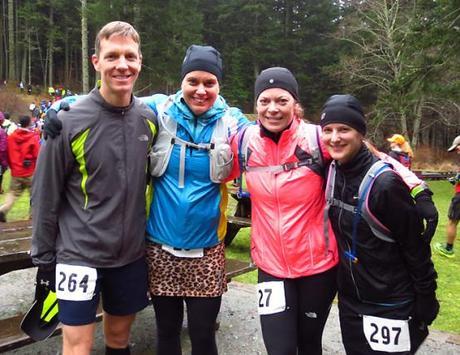
Me, Julie, Charlotte and Kathie flash our “warm and dry” smiles one last time
Because we’d all gathered indoors until the last minute, I’d neglected to give my Garmin the extra time it needed to find the GPS satellites and figure out where it was. Apparently the impenetrable cloud canopy confused its California sensibilities, because it kept searching for satellites and asking me “Are you indoors now?” as raindrops bounced off its display. Not the brightest gadget, so after about half a mile I gave up and – for the first time since I’d unwrapped it on Christmas Day 2008 – resigned myself to racing without my Garmin. So this is how our forefathers did it.
Aside from short stretches on paved roads, the first 5.6 miles were exactly what I had envisioned for a trail run in the Pacific Northwest: muddy, leaf-strewn singletrack snaking through rainforest-like surroundings, past now-torrential Cascade Falls, around pristine Cascade Lake, as well as over and under moss-covered branches. One key difference between road and trail races is the mental fatigue caused by running on rugged, uneven terrain: I couldn’t let my guard down even momentarily for fear I’d slip on a patch of mud, twist my ankle on a slippery rock or trip over a partially exposed tree root. This constant vigilance in harsh conditions would take its toll by race end, and in the aftermath I’d encounter several runners with sprained ankles and scraped-up knees. Such are the casualties of trail racing.
I first saw Katie with camera poised at Cascade Falls (near mile 3), then again at the Camp Moran North Arch (mile 5.6), just after the first of two aid stations. I tossed her my gloves and turned my attention to the first major challenge of the day, the much-anticipated Powerline Trail.
Rather than having us run the more gradual switchback route, James routed this year’s course straight up the Powerline Trail, which is primarily used during dry months by mountain bikers coming down the trail. After the race I asked Julie, Charlotte and Kathie to describe the Powerline Trail in one word; several dazed seconds later, each just shook her head as if trying to clear it of the horror.
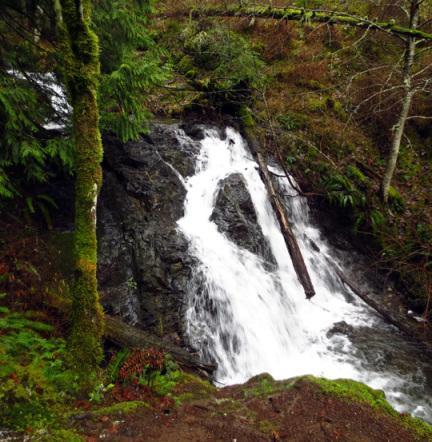
Cascade Falls
“Abomination” was the word that came to mind as I struggled to ascend the steep, muddy slope. The slick mud immediately reclaimed any forward progress I made until eventually, by pulling myself up on exposed tree roots and stepping in the recessed footprints of other runners, I was able to ascend the first and steepest pitch of the trail. From there the trail turned just grassy enough to enable forward progress, but only by walking sideways uphill. That was a racing first for me. As I doggedly passed several runners-turned-hikers, one woman remarked, “This is an Achilles injury waiting to happen.” By focusing five feet ahead of me, I was able to maintain a slow jogging pace up most of the Powerline Trail, while my quads and lower back protested the strain of laboring up a muddy hill at a 45° angle.
As both the Powerline Trail and the ache in my quads began to level off (mile 7.3, I heard someone announce), I realized the steady rain had transitioned to steady snow. The next 6+ miles would be my first time racing in a winter wonderland, with much of the trail at least partially covered in snow. Fortunately icy patches on the trail were minimal; however, footing was slowed by the accumulated snow, which made momentum and rhythm elusive prey.
Our second major climb of the day began at ~mile 9.6 and ascended a switchback route to the summit of Mount Constitution. After jogging the first couple of switchbacks and speed-hiking the next, I fell into a jog behind two strong uphillers whose steady pace carried me to the summit. Here the snow accumulation topped a foot, though I was generating enough body heat that cold wasn’t an issue. Relieved as I was to have reached the zenith of the course, I was disappointed to find that road closures had prevented Katie from accessing the summit. And the snow-spitting sky ensured there would be no panoramic vistas today. No Mount Baker to the east, no Mount Rainier or Mount St. Helens to the south.
Following the trail of pink ribbons and the footprints of previous runners through the packed snow, I passed the second/final aid station at mile 12, where I thanked the shivering volunteers without breaking stride. Based on my memory of the course elevation profile, I was hoping the final 3.5 miles would amount to a super-squishy downhill victory lap.

At mile 5.6, the Moran State Park Arch (left) doubles as the gateway to the Powerline Trail (right)
The highlight of the course, and hands-down one of the (literally) coolest things I’ve ever seen while racing, was snowed-over Summit Lake between miles 12 and 13. If I’d had my camera – or even my camera phone – I would have stopped to snap a few pictures of the tranquil, picturesque landscape. I’m surprised I didn’t launch myself headlong over a tree root while admiring the expanse of frozen white.
For a 250-person race, I spent a surprising amount of time running by myself. Much of miles 2-6 (up to the start of the Powerline Trail), miles 7.5-9.5 (between major ascents) and mile 12 to the finish were spent in solitude, and I was able to enjoy the natural beauty of Orcas Island without having to worry about passing or being passed on sodden singletrack.
By the time the snow and ice transitioned back to rain and mud, I was eager to stretch my legs and make up for lost time. Emboldened by more reliable footing with fewer large rocks and tree roots, my stride became more fluid, and I barely blinked as overhanging fern fronds swatted me wetly in the face. Despite my faster pace, I was shocked that only a single runner passed me on the ~4-mile descent to the finish. I expected that a caravan of reckless, eager-to-finish runners would overtake me, but then again that’s what prolonged steep ascents will do to you… the will may be there at the end, but the stamina is gone.
With neither my Garmin nor a single mile marker to gauge distance, the last four miles were peaceful yet seemingly endless. Refusing to let my tired mind think ahead to the finish line, I arbitrarily repeated “1-1/2 miles to go” to myself while trying to maintain an aggressive pace. With about a mile to go my victory lap was rudely interrupted by a nasty uphill jag, which although unwelcome would hopefully reinforce my lead over any unseen pursuers.
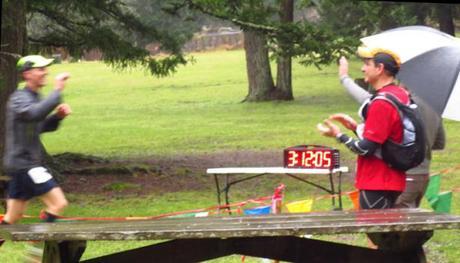
Surging toward my hard-earned high five from James (hidden from view, with umbrella)
As I re-emerged onto paved Olga Rd, black arrows on yellow signage pointed the way home past rows of parked cars. A final uphill surge brought me to the precipice of Camp Moran, where turning left I dropped down the muddy slope, crossed the grassy field and – with Katie’s cheers penetrating my mud-brain barrier – high-fived James to finish with an official time of 3:12:06.
Mentally more than physically exhausted, I reunited with Katie (who’d wisely sought out the relatively dry comfort of the cabin porch) and stood watching the action while slowly regaining my wits. Then I hurried inside to towel off and don dry clothes, before returning outside to await the others. Exactly an hour later the three of them emerged as a group into Camp Moran, finishing within 30 seconds of each other and looking as dazed as I’d felt an hour earlier.
The consensus among Julie, Charlotte and Kathie was overall displeasure with James’ new-&-improved course design. Another of Julie’s Seattle running buddies, who’d run this race last year, finished more than 38 minutes behind her 2012 time. And I overheard another runner voice the sentiment that had crossed my own mind late in the race: “Most of the marathons I’ve run were easier than this.” Kathie (though not Julie) agreed. At any rate, this had been a whale of a course.
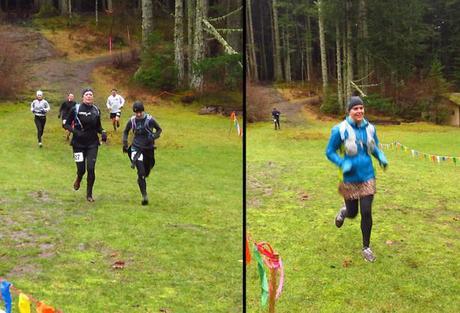
You go, girls! Charlotte, Kathie and Julie in a photo(genic) finish
On the other hand I did run a 25K PR on Orcas Island… though in the interest of full disclosure, I’d gotten lost (along with the leader at the time) during my only other 25K and ended up extending that race by 3 or so miles.
The winner finished with a mind-blowing time of 2:17:12; I’d love to watch the video of his ascent up the Powerline Trail. And Andrew Fast did his surname proud with a second-place finish in 2:22:59.
In the main cabin I stabilized my blood glucose levels at the post-race spread while waiting for the others to shed their wet gear in favor of dry clothes. Then, with the double whammy of stifling heat and dank musty runner threatening to overpower us, we made our exit.
We compared race notes over a life-affirming lunch at Tee-Jays, a hole-in-the-wall Mexican eatery in chilly, seagull-rich Eastsound. Apparently Charlotte had tripped at one point and managed to twist in midair to avoid landing on her previously broken (and still-healing) wrist and elbow; she’d escaped with a bloodied knee and bruised hip. Julie recalled another runner whom she alleged had been “endorphin goggling,” based on supposedly flattering comments he’d made while running behind the three of them (I’m guessing her cheetah skort inspired him).

Eastsound was swathed in fifty decidedly unerotic shades of grey
We killed a leisurely afternoon in Eastsound before making our way to the docks in time to catch the evening ferry back to Anacortes. From there, as a collective exhaustion settled over the car, Julie navigated the 80-mile return trip to Redmond through darkness and driving rain. In Redmond we said our goodbyes and cheerfully parted ways with Kathie and Charlotte, who had been terrific travel companions. That night I barely remember my head hitting the pillow on the pull-out sofa bed in Julie and David’s guest room. Even the sound of her son, from his room next door, urgently calling for his mom in the wee hours of the morning barely registered through the haze of my Powerline-induced stupor.
In retrospect, Orcas Island was one of the most memorable and surreal races I’ve run. In just two days we covered a lot of ground – by car, by ferry and by foot – in a variety of weather conditions – first sun, then rain, then snow. Thanks to Julie’s persistence in luring us to Washington and her hospitality once we arrived, I spent quality time with her family, met new and interesting people, immersed myself in the Pacific Northwest trail running culture… and returned to the Bay Area with a rattling cough that has slowly succumbed to sunshine and 60° temperatures.
Hey, that’s what friends are for.
*******
PRODUCTION: Unlike my travel companions, I appreciated the difficulty of the new course. I figure if I’m flying to Seattle, driving 80 miles north, hopping a ferry to Orcas Island and then driving another 15 miles to the race site, I want a legitimate challenge and not a flat out-and-back on paved streets. What I don’t want is Rock ‘n’ Roll Orcas Island.
James and his crew did a nice job of marking the course… wherever the possibility existed for a wrong turn, pink ribbons and arrow signs pointed the way. But although I stayed on course throughout, there were lengthy stretches of solitary running where a “reassurance ribbon” would have eased my mind. Just a thought for next year’s race.
Race registration itself cost only $45, plus a $3.25 processing fee; however, this price of admission didn’t include the ferry ($85 for our five-person vehicle), the Washington State Discovery Pass required to enter Moran State Park ($10 for one day or $30 for an annual pass), or lodging. So depending on how many people travel together and where they stay, Orcas Island could end up being a less-than-frugal outing.
The race volunteers can never be thanked enough; they were tremendously helpful, friendly and wet. And the post-race spread was to my liking: plenty of fruit (bananas, oranges and pineapple) and sugary drinks, plus local microbrews, soup and a well-stocked sandwich counter.
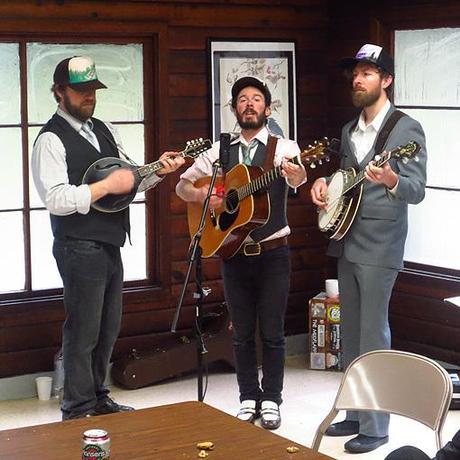
The Pine Hearts provided post-race music… Katie guessed “Indigo Girls” on every song
As for race swag: unless INKnBURN is involved I’m not a huge t-shirt guy, so I appreciated the “reuse and recycle” ethic practiced by James and his crew. My biggest disappointment wasn’t the lack of a conventional race t-shirt, nor the quad-busting course, nor even my failure despite my best efforts to give myself pneumonia. No, ’twas the lack of finisher’s bling that most conspicuously cast its cruel shadow across this otherwise radiant heart.
The medal doesn’t have to be fancy – it can be something old, new, borrowed or blue. It just has to be SOMETHING. A reminder of the Orcas Island 25K that years from now still triggers instant memories of the Powerline Trail and Summit Lake. I know that “real” trail runners – those who claim to run out of a sheer love of nature and their fellow man – typically reject the notion of medals (and other material possessions). And granted, if there were no medals I’d still run, and run hard. But at the same time, seeing the number of runners last weekend happily sporting “Orcas Island 25K” argyle pullovers or Hawaiian aloha shirts, I’d be surprised if most of them weren’t also medal-grubbing types like me.
If and when I make it back to the Pacific Northwest, I’d definitely race with James and his Rainshadow Running crew again. Especially if next time they have medals.
GEAR: Faced with slick mud, slippery rocks, ankle-deep snow and patchy ice, my Merrell Mix Master 2s again outperformed the rest of me. Orcas Island was their toughest test to date, yet the shoes remained grip-tastic and provided reliable footing over the entire 25+K. Now if only Merrell would make a trail shoe that lifted itself over rocks and tree roots when its owner got tired…
BOTTOM LINE: If you’re new to trail running and looking for a first-timer’s race to ease yourself into the sport, keep looking because this one’s not for you. But if you’re a trail racing aficionado seeking a low-key yet challenging race in a picturesque setting, I’d recommend Orcas Island in an (elevated) heartbeat. And admittedly I’m now intrigued by the 50K, which will be held this Saturday and which includes 8,400ft of elevation change.
CHECK OUT CHARLOTTE’S RACE REPORT FOR ANOTHER (MORE CONCISE) PERSPECTIVE.
FINAL STATS: (thanks to Charlotte for distance and elevation change data)
16.34 miles (26.3 km) on Orcas Island in Olga, WA
Finish time & pace: 3:12:06 (first time running Orcas Island), 11:45/mile
Finish place: 32/244 overall
Race weather: windy, rainy, snowy and cold (temps ranging from low 30s to low 40s)
Elevation change (Garmin Connect software): 4,505ft total gain/loss
